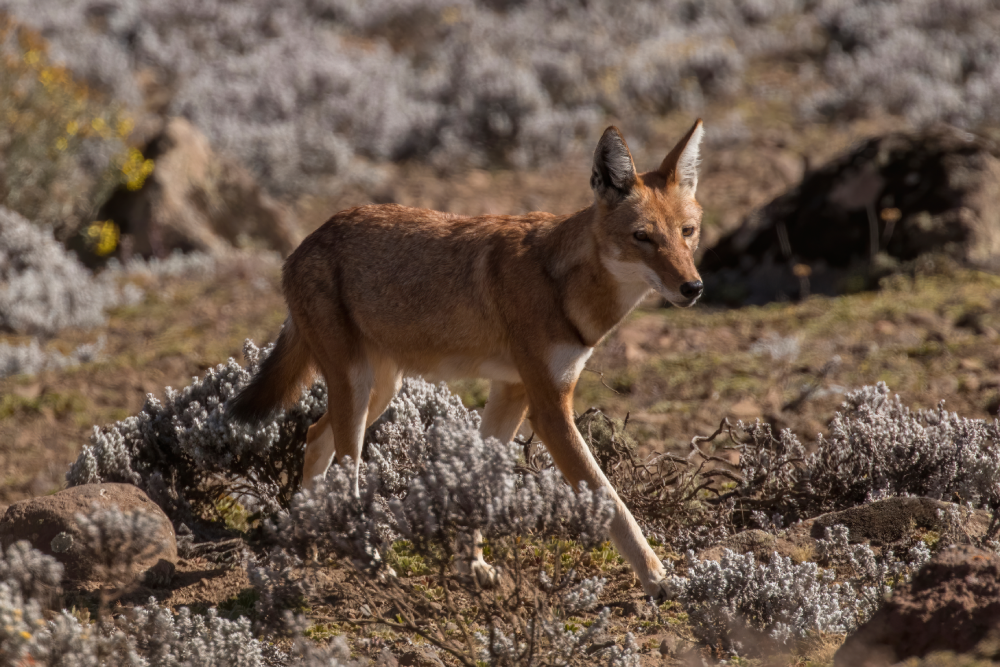The Ethiopian wolf (Canis simensis), Africa’s most endangered carnivore, is a striking and unique species of canid that inhabits the highlands of Ethiopia. Known for its slender build and reddish coat, the Ethiopian wolf is not just another member of the Canidae family but a distinct and specialized predator that has evolved to thrive in one of the continent’s most challenging environments. This article delves into the natural history, ecology, behavior, conservation status, and the ongoing efforts to preserve this remarkable species.
Natural History and Description
The Ethiopian wolf, also referred to as the Simien jackal or Abyssinian wolf, is the world’s rarest canid. It is slightly smaller than a coyote and has a distinctive appearance, with a reddish-brown coat, white underparts, and long, slender legs. The face has a pointed snout, erect ears, and a narrow muzzle, giving it a fox-like appearance. Adult males typically weigh between 14 to 20 kilograms, while females are slightly smaller, weighing between 11 to 16 kilograms.
Ethiopian wolves are found only in Ethiopia, specifically in isolated pockets of the Ethiopian Highlands at elevations between 3,000 and 4,500 meters. The largest populations are located in the Bale Mountains National Park, the Simien Mountains, and the Guassa-Menz regions. These high-altitude habitats are characterized by Afro-alpine grasslands and heathlands, environments that are subjected to harsh weather conditions, including cold temperatures and significant seasonal variations.

Ecology and Behavior
The Ethiopian wolf is a professional predator, primarily preying on the abundant Afro-alpine rodents. Their diet consists mainly of grass rats, giant molerats, and other small mammals, which they hunt with remarkable precision and skill. The wolves have adapted to their environment with a hunting strategy that involves stealth and patience, often using their keen sense of hearing to locate prey.
Socially, Ethiopian wolves are unique among canids due to their complex social structures. They live in packs, but unlike other canids such as wolves and African wild dogs, Ethiopian wolf packs are less cohesive. Packs typically consist of an alpha pair, subordinate males, and females. Only the alpha pair breeds, while the other members assist in raising the pups and defending the territory. This cooperative breeding strategy is crucial for the survival of the species, given the limited resources and harsh conditions of their habitat.
Conservation Status
The Ethiopian wolf is classified as Endangered by the International Union for Conservation of Nature (IUCN), with an estimated population of fewer than 500 individuals. The primary threats to their survival include habitat loss, disease, and hybridization with domestic dogs.
Habitat Loss: The highlands of Ethiopia are under significant pressure from human activities such as agriculture, livestock grazing, and settlement expansion. These activities lead to habitat fragmentation and degradation, reducing the available range for the wolves and increasing competition for resources.
Disease: Rabies and canine distemper, transmitted by domestic dogs, pose significant threats to the Ethiopian wolf population. Outbreaks of these diseases have led to dramatic declines in wolf numbers in several areas.
Hybridization: Interbreeding with domestic dogs not only poses a threat through disease transmission but also through genetic dilution. Hybridization can result in the loss of unique genetic traits that are crucial for the Ethiopian wolf’s survival in its specialized niche.
Conservation Efforts
Numerous efforts are underway to conserve the Ethiopian wolf, focusing on habitat protection, disease control, and community engagement.
Protected Areas: Establishing and effectively managing protected areas such as the Bale Mountains National Park and the Simien Mountains National Park is crucial. These areas provide a sanctuary for the wolves and other endemic species, helping to mitigate the impacts of habitat loss.
Disease Control: Vaccination programs for domestic dogs in and around wolf habitats are essential to controlling rabies and canine distemper outbreaks. These programs are often conducted in collaboration with local communities and international organizations.
Community Engagement: Involving local communities in conservation efforts is vital for the long-term survival of the Ethiopian wolf. Education and awareness campaigns help to foster a sense of stewardship among local residents, encouraging them to participate in conservation activities and reduce conflict between humans and wildlife.
Research and Monitoring: Ongoing research and monitoring are critical to understanding the dynamics of Ethiopian wolf populations and their habitats. This information is used to inform and adapt conservation strategies, ensuring they remain effective in the face of changing environmental and social conditions.
Conclusion
The Ethiopian wolf is a remarkable species, uniquely adapted to the Afro-alpine environments of the Ethiopian Highlands. Despite facing numerous threats, concerted conservation efforts provide hope for its survival. Protecting the Ethiopian wolf requires a multifaceted approach that combines habitat protection, disease management, and community involvement. So, by addressing these challenges, we can ensure that this unique canid continues to roam the highlands of Ethiopia, maintaining its place as a vital part of the ecosystem and a symbol of the region’s rich natural heritage.









